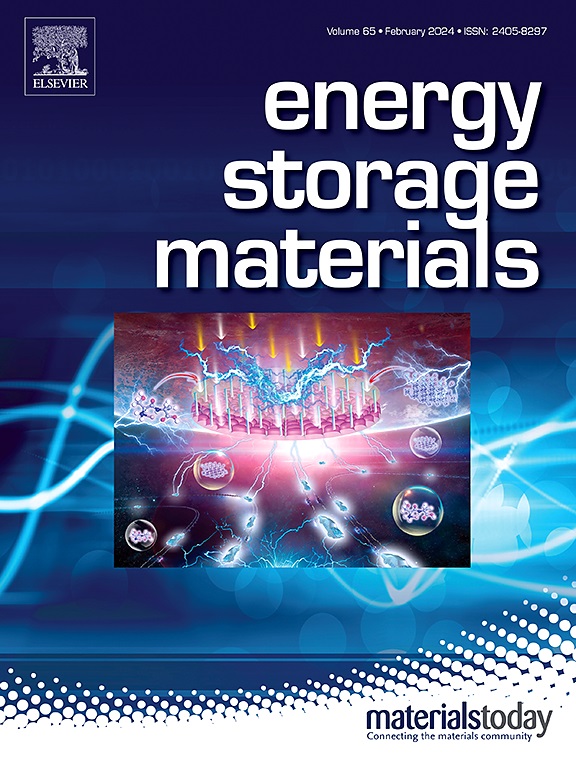Unlocking the potential of fossil fuel-derived hard carbons in sodium-ion batteries: Mechanistic insight and design strategies
IF 20.2
1区 材料科学
Q1 CHEMISTRY, PHYSICAL
引用次数: 0
Abstract
Sodium-ion batteries (SIBs) have garnered significant attention as an attractive energy storage complementary technology to lithium-ion batteries (LIBs) and could be critical in future electric vehicles and large-scale energy storage systems. The anode material, as an important component of SIBs, has a decisive influence on their electrochemical performances. Among available anode materials, hard carbons are regarded as the practical anode materials for SIBs. Suitable precursors are crucial for producing economical and high-quality hard carbons. Given the low cost, abundant availability, high carbon content, and specific organic structures, fossil fuels have been considered as an ideal carbon resource for hard carbons. However, the complex composition and high aromaticity of fossil fuels result in uncontrollable pyrolytic structural evolution and highly graphitized microstructure, which hinders the development of high-performance hard carbon anodes. In this review, we provide a comprehensive overview of the structural model evolution and classification of fossil fuels and hard carbon. Subsequently, we analyzed in depth the similarities and differences in the pyrolysis behavior of various fossil fuels. Based on these fundamental insights, we summarize the effects and limitations of various modification strategies on fossil fuel-derived hard carbons. Finally, we highlight the key challenges and future research directions for next-generation high-performance fossil fuel-derived carbon anodes, particularly in molecular design of fossil fuels, multiscale characterizations and big data analytics of hard carbons, and compatibility with other components of SIBs.


释放钠离子电池中化石燃料衍生硬碳的潜力:机械洞察和设计策略
钠离子电池(SIBs)作为锂离子电池(LIBs)的一种有吸引力的储能补充技术,在未来的电动汽车和大规模储能系统中可能至关重要,因此备受关注。阳极材料作为sib的重要组成部分,对sib的电化学性能有着决定性的影响。在现有的阳极材料中,硬质碳被认为是sib的实用阳极材料。合适的前驱体是生产经济、高质量硬炭的关键。化石燃料具有成本低、可得性丰富、含碳量高、有机结构特殊等特点,被认为是硬碳的理想碳源。然而,化石燃料的复杂成分和高芳香性导致其热解结构演变不可控,微观结构高度石墨化,阻碍了高性能硬碳阳极的发展。本文对化石燃料和硬碳的结构模式演化和分类进行了综述。随后,我们深入分析了各种化石燃料热解行为的异同。基于这些基本见解,我们总结了各种改性策略对化石燃料衍生的硬碳的影响和局限性。最后,我们强调了下一代高性能化石燃料衍生碳阳极的关键挑战和未来的研究方向,特别是在化石燃料的分子设计,硬碳的多尺度表征和大数据分析以及与sib其他组分的兼容性方面。
本文章由计算机程序翻译,如有差异,请以英文原文为准。
求助全文
约1分钟内获得全文
求助全文
来源期刊

Energy Storage Materials
Materials Science-General Materials Science
CiteScore
33.00
自引率
5.90%
发文量
652
审稿时长
27 days
期刊介绍:
Energy Storage Materials is a global interdisciplinary journal dedicated to sharing scientific and technological advancements in materials and devices for advanced energy storage and related energy conversion, such as in metal-O2 batteries. The journal features comprehensive research articles, including full papers and short communications, as well as authoritative feature articles and reviews by leading experts in the field.
Energy Storage Materials covers a wide range of topics, including the synthesis, fabrication, structure, properties, performance, and technological applications of energy storage materials. Additionally, the journal explores strategies, policies, and developments in the field of energy storage materials and devices for sustainable energy.
Published papers are selected based on their scientific and technological significance, their ability to provide valuable new knowledge, and their relevance to the international research community.
 求助内容:
求助内容: 应助结果提醒方式:
应助结果提醒方式:


